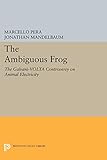The Ambiguous Frog : The Galvani-Volta Controversy on Animal Electricity / Marcello Pera.
Material type: TextSeries: Princeton Legacy Library ; 173Publisher: Princeton, NJ : Princeton University Press, [2014]Copyright date: ©1991Edition: Course BookDescription: 1 online resource (232 p.)Content type:
TextSeries: Princeton Legacy Library ; 173Publisher: Princeton, NJ : Princeton University Press, [2014]Copyright date: ©1991Edition: Course BookDescription: 1 online resource (232 p.)Content type: - 9780691603971
- 9781400862498
- 591.19127
- QP341 -- P4713 1992eb
- online - DeGruyter
- Issued also in print.
| Item type | Current library | Call number | URL | Status | Notes | Barcode | |
|---|---|---|---|---|---|---|---|
 eBook
eBook
|
Biblioteca "Angelicum" Pont. Univ. S.Tommaso d'Aquino Nuvola online | online - DeGruyter (Browse shelf(Opens below)) | Online access | Not for loan (Accesso limitato) | Accesso per gli utenti autorizzati / Access for authorized users | (dgr)9781400862498 |
Frontmatter -- Contents -- List of Illustrations -- Foreword -- Acknowledgments -- List of Abbreviations -- Introduction -- Chapter 1. Electricity, the Science of Wonders -- Chapter 2. Volta's and Galvani's Scientific Training -- Chapter 3. Galvani's Experiments and Theory -- Chapter 4. Volta's First Reaction -- Chapter 5. The Crucial Experiments -- Chapter 6. The Pile -- Notes -- References -- Name Index
restricted access online access with authorization star
http://purl.org/coar/access_right/c_16ec
How do ideas become accepted by the scientific community? How and why do scientists choose among empirically equivalent theories? In this pathbreaking book translated from the Italian, Marcello Pera addresses these questions by exploring the politics, rhetoric, scientific practices, and metaphysical assumptions that entered into the famous Galvani-Volta controversy of the late eighteenth century. This lively debate erupted when two scientists, each examining the muscle contractions of a dissected frog in contact with metal, came up with opposing but experimentally valid explanations of the phenomenon. Luigi Galvani, a doctor and physiologist, believed that he had discovered animal electricity (electrical body fluid existing naturally in a state of disequilibrium), while the physicist Alessandro Volta attributed the contractions to ordinary physical electricity. Beginning with the electrical concepts understood by scientists in the 1790s, Pera traces the careers of Galvani and Volta and explains their laboratory procedures. He shows that their controversy derived from two basic, irreducible interpretations of the proper nature of a common domain: Galvani saw the frog phenomenon as the work of biological organs, Volta as that of a physical apparatus. The initial preference for Volta's theory, maintains Pera, depended not on clear-cut methodological rules, but on a dialectical dispute for which the renowned physicist was better equipped, partly because he shared the dominant metaphysical views of his time.Originally published in 1991.The Princeton Legacy Library uses the latest print-on-demand technology to again make available previously out-of-print books from the distinguished backlist of Princeton University Press. These editions preserve the original texts of these important books while presenting them in durable paperback and hardcover editions. The goal of the Princeton Legacy Library is to vastly increase access to the rich scholarly heritage found in the thousands of books published by Princeton University Press since its founding in 1905.
Issued also in print.
Mode of access: Internet via World Wide Web.
In English.
Description based on online resource; title from PDF title page (publisher's Web site, viewed 30. Aug 2021)


